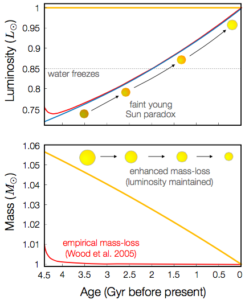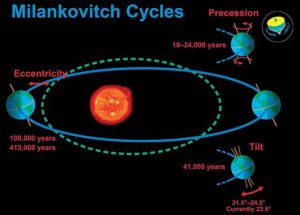The Earth is an ocean world, and geological evidence in the form of ancient, indestructible zircon mineral grains indicates the Earth has had liquid water on its surface going almost back to its beginning.
The persistence of Earth’s oceans is surprising since stars like the Sun brighten with age as they gravitationally contract. In fact, in 1972, Sagan and Mullen showed that, 2.3 billion years ago, the Sun should have been about 15% dimmer than today — dim enough that, if the atmosphere resembled today’s, the Earth should have frozen over. But somehow, it didn’t.

Evolution in the past of the Sun’s luminosity (top) and mass (bottom) for different scenarios. From Spaulding et al. (2018).
A recent study by Spaulding, Fischer, and Laughlin explores one possible solution of the famous “faint young Sun paradox” — over 4.5 billion years, the Sun has been slimming down.
All stars like the Sun lose mass over billions of years through stellar (or solar) wind. This flood of hot, charged particles continually escapes from a star’s atmosphere, streaming into space. (When the solar wind strikes the Earth’s atmosphere, it gives rise to aurorae.)
Even though the Sun’s stream is currently more breeze than wind, it was probably much stronger billions of years ago, removing perhaps 1% of the Sun’s original mass over the Sun’s lifetime (about 3,000 times Earth’s mass) — red line in the bottom panel of the figure at left.
Since a star’s brightness (luminosity) depends very sensitively on its mass, the larger original mass means the Sun would have been a little brighter early on than otherwise. But 1% is not enough to completely cancel out the “faint” part of the young Sun paradox.
However, Spaudling and colleagues point out that estimates of the mass loss during the Sun’s youth are based on limited observations of other young stars and are so are uncertain. Maybe, they suggest, the loss rate was much larger than suspected (the yellow line in the bottom panel of the figure). In this case, the Sun could maintain about the same brightness it has today (yellow line, top panel), side-stepping the paradox altogether.

Oscillations of the Earth’s orbital eccentricity and pole position.
Now, whether this idea holds water remains to be seen, but Spaulding and colleagues suggest we could test their hypothesis by studying sediment deposits on the Earth from billions of years ago.
It turns out that the chemistry and mineralogy of sediments at a given location on Earth depend on contemporaneous climate, and geologists have actually used 1.4-billion-year-old sediments found in China to understand Earth’s ancient tropical meteorology.
Ancient sediments such as these show a clear periodic oscillations, over tens and hundreds of thousands of years, probably linked to variations in Earth’s orbit and pole. Indeed, the Serbian mathematician Milutin Milanković noticed the connection between Earth’s orbit and climate back in the early 20th century, and these oscillations are now called Milanković cycles.
Since the pull of the Sun’s gravity set the pace of this cosmic waltz, in principle, the periodicities exhibited by these sediments should reflect the Sun’s mass. And so Spaulding and colleagues suggest that, with the right deposits, we could spot the slow deceleration of Milanković cycles over billions of years and work out the evolution of the Sun’s mass.
It’s not clear that such an analysis is currently feasible, given the typically large uncertainities involved in age-dating of ancient sediments. But recent work in this direction has used the Chinese sediments to work out details of the Earth and the Moon’s orbit. So astronomers may soon be sifting the dirt to study the stars.